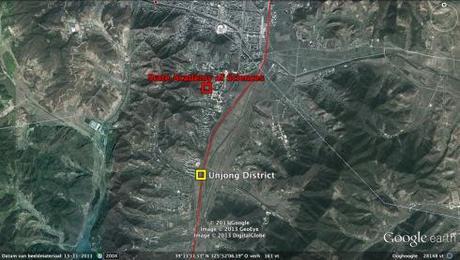
A view of the Unjong District and State Academy of Sciences between Pyongyang and P’yo’so’ng, South P’yo’ngan Province. (Photo: Google images)
The DPRK is developing a science and technology industrial park in the State Academy of Sciences complex. Taiwanese magazine Cho Yueh, whose writer toured the area, reported in its December 2012 issue that Kim Jong Il established the Unjong Development Zone (a.k.a. Unjong New and High [advanced] Technology Zone) in October 2011. In June 2012 the Unjong High Technology Company was established under the auspices of the State Academy of Sciences Technology Trade Bureau. The Unjong Development Zone will be organized as a special economic zone [SEZ], similar to the Raso’n (Rajin-So’nbong) and Hwanggu’mp’yo’ng/Sinu’iju SEZs. The Unjong zone and company will be under the direct management and supervision of the DPRK Cabinet with Kim Yong Gil serving as company president and Pak Won Chol serving as company vice president. The DPRK has set aside 4, 500 mu (300 hectares; 3, 000, 000 square meters) for the Unjong Development Zone with designated areas for management and administration, life science, information technology, nanotechnology and advanced industrial equipment. According to Cho Yueh, the zone is modeled after the Hsinchu Science and Industrial Park. Companies that invest in the Unjong Development Zone can link to any of the relevant State Academy of Sciences 40 different research institutions and 10,000 employees, and be able to hire from the DPRK’s cost-effective labor pool. In order to attract the $1.5 billion (USD) in investments in the Unjong Development Zone, the DPRK has authorized a low rents within the zone, scheduled tax breaks and exemptions and a waiver on duty for raw materials and exports.
DPRK state media has not extensively reported about the Unjong Development Zone, which indicates that the zone remains in the planning stages. Around the time that Kim Jong Il authorized the zone’s establishment in October 2011 (confirmed through other sources), he traveled from the northern outskirts of Pyongyang (where he visited the Central Tree Nursery) to P’yo’ngso’ng (where he visited the P’yo’ngso’ng Synthetic Leather Factory). His travel route between these two locales would have found him passing through the tightly guarded Unjong District (kuyo’k) and his itinerary at the time would have allowed KJI to make an unreported visit to the area earmarked for the Unjong Development Zone.
DPRK Cabinet Premier Choe Yong Rim has visited the State Academy of Sciences main campus (as opposed to branch offices or subordinate institutions located elsewhere) in November 2011 and November 2012. During Choe’s 2012 visit, when meeting with the academy’s managers and key officials, “technical measures for preferentially supplying equipment and raw materials needed for scientific researches and face-lifting the Unjong area of science.” The Unjong Development Zone may have been a topic of discussion when a DPRK delegation visited Taiwan in June 2012, after the creation of the Unjong High Technology Company (hence, a Taiwanese delegation securing access to what is currently a sensitive facility); during those interactions, the Raso’n and Hwanggu’mp’yo’ng SEZs were discussed. On 12 December 2012 the DPRK signed a loan agreement with the Kuwait Fund for Arab Economic Development. That loan will finance the construction of a new road between Pyongyang and P’yo’ngso’ng, which will pass by the Unjong Development Zone. The DPRK has also undertaken long-term policy initiatives that could benefit the Unjong SEZ. The 6th session of the 12th Supreme People’s Assembly [SPA] on 25 September 2012 revamped the national education curriculum, and the country has been receiving advice from German experts to make the country more conducive to foreign investment.
A Taiwanese executive with experience in the DPRK told Cho Yueh that “This is very special. In the past, the DPRK establishes economic development zones mainly in the border area adjacent to other countries so that it was easy to carry out management, but the Unjong Development Zone has been built in a place only 30 km (19 miles) from Pyongyang. It is thus clear the DPRK has changed policies in order to develop the economy. Whether or not it will advance toward reform and opening-up remains an issue to be observed.” The biggest obstacle to the DPRK’s plans for Unjong are numerous United Nations [UN] and unilateral sanctions for the country’s ongoing nuclear weapons and ballistic programs. Due to the nature of its mission, in addition to conducting civilian research in the light industrial and agricultural sectors, the State Academy of Science has been a key contributor to the DPRK strategic weapons and space programs.
Filed under: Choe Yong Rim, critical infrastructure, DPRK Cabinet, DPRK External Relations, DPRK Premier, DPRK-Kuwait Relations, DPRK-Taiwan (ROC) Relations), Guidance Tours, Hwanggumphyong (Hwanggu'mp'yo'ng) Economic Zone, Jang Song-thaek, Kim Jong-il, KJI Personal Secretariat, Korean Workers' Party (KWP), land and enviroment, Ministry of Foreign Trade, North Korean press, Rajin-So'nbong People's Committee, Raso'n Economic Zone, State Academy of Sciences, State Planning Commission (SPC), State Science and Technology Commission, Supreme People's Assembly
